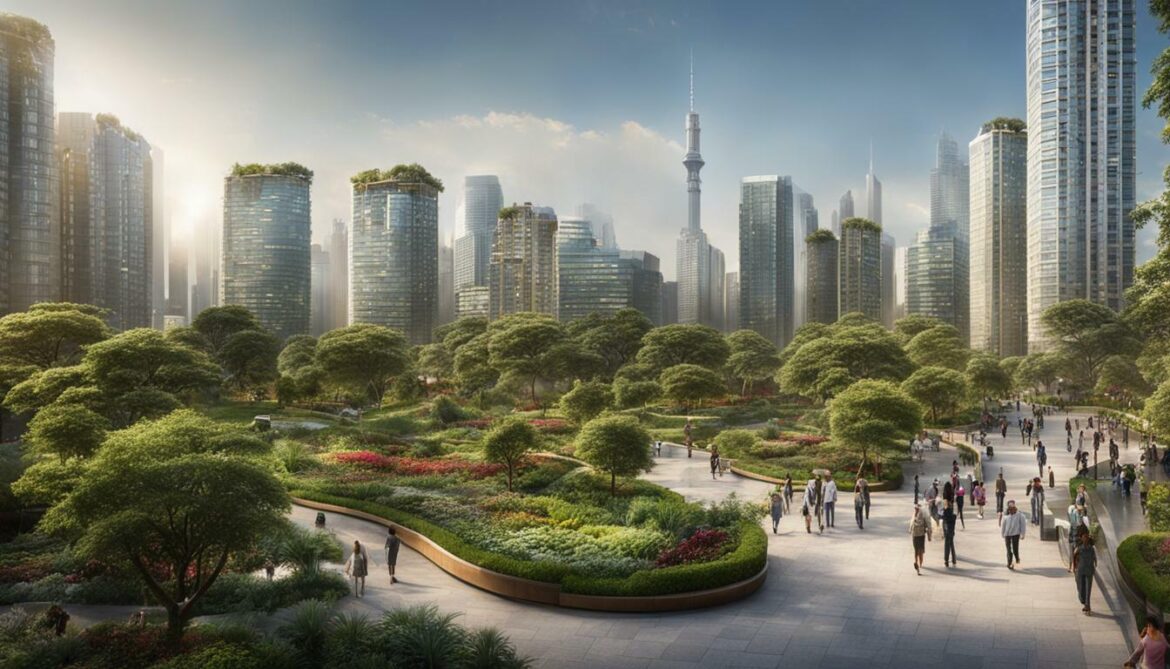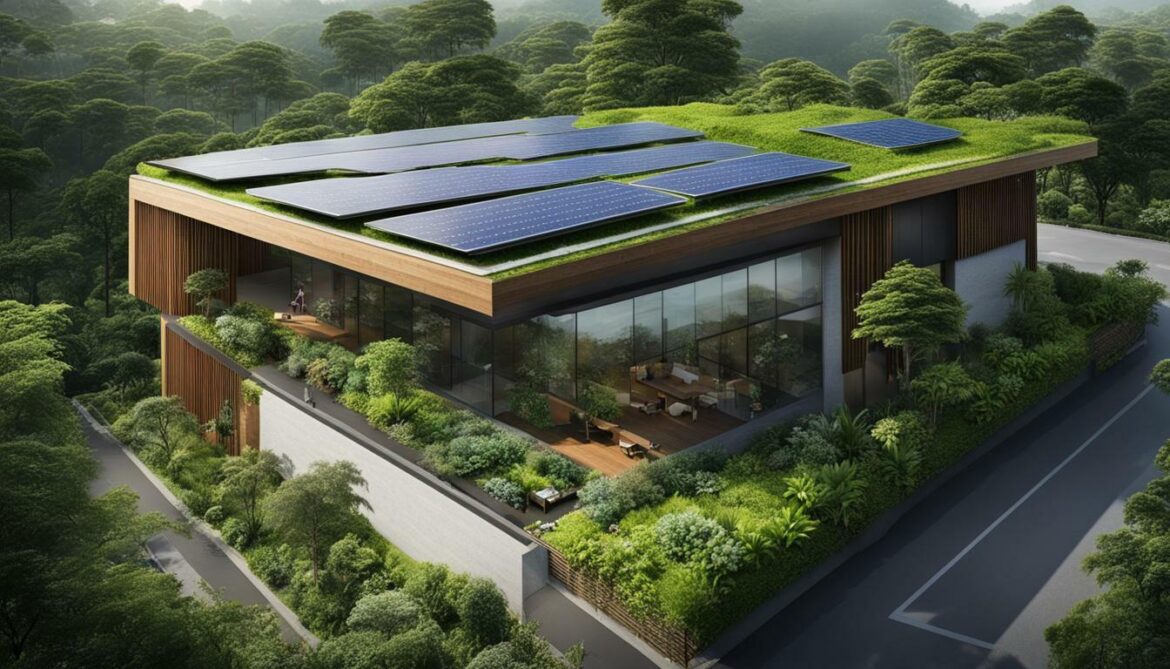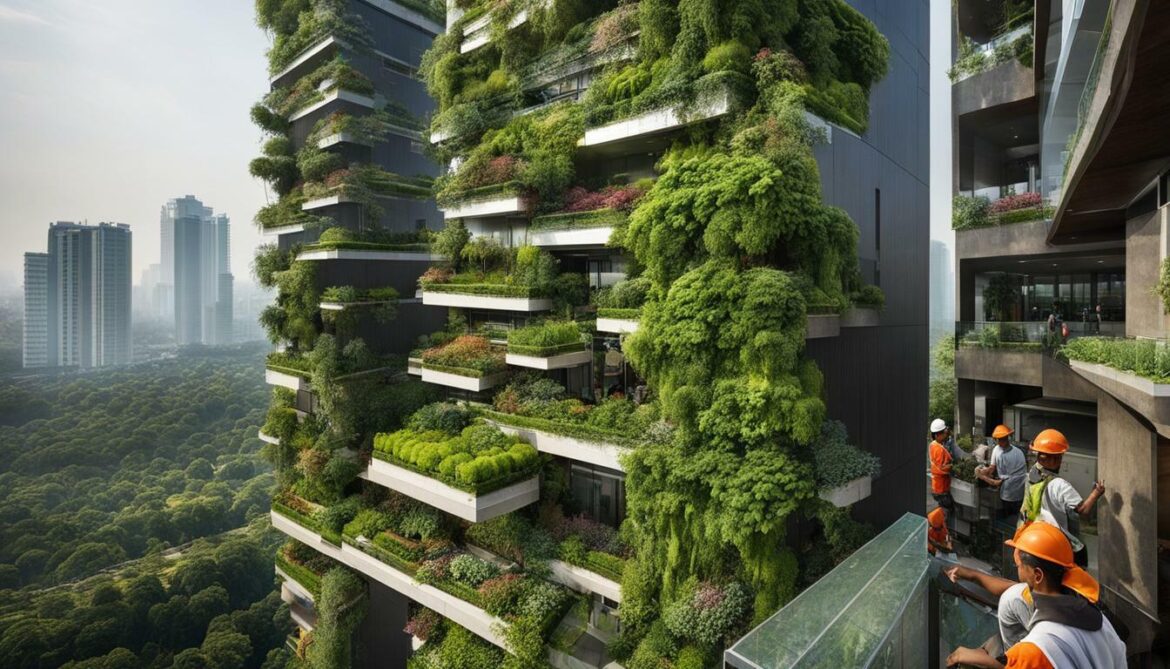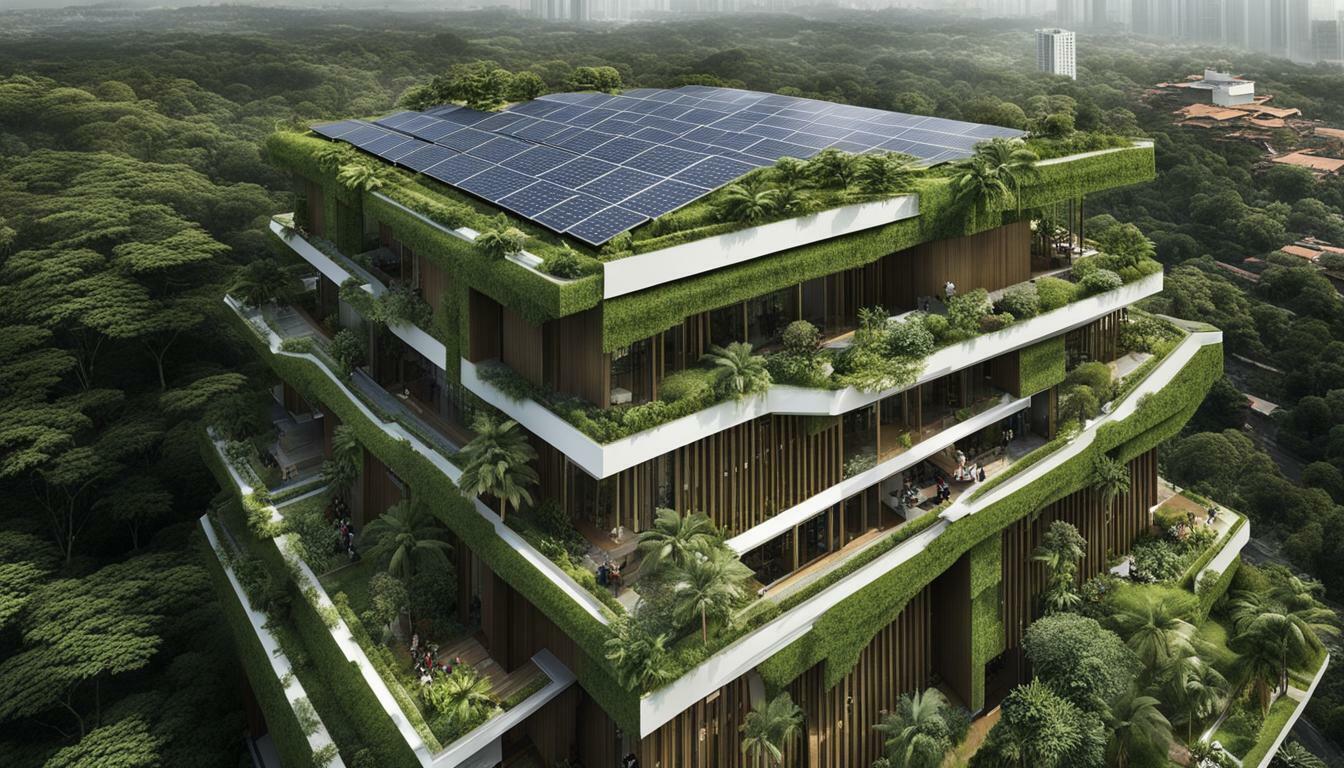The history of green building practices in Indonesia showcases the country’s commitment to sustainable construction and environmentally friendly architecture. Indonesia has made significant progress in embracing green building practices, aiming to create a more sustainable future.
- Indonesia has seen significant progress in green building practices, with over 100 buildings receiving voluntary green building certifications.
- A joint study by the Green Building Council Indonesia and the International Finance Corporation (IFC) revealed that green certified buildings in Jakarta achieved 30 to 80 percent lower annual utility costs compared to standard buildings.
- The government is pushing for higher energy efficiency in buildings as the sector accounts for 30 percent of the country’s total energy consumption.
- The long-term financial and environmental benefits of green buildings are promising.
- The green building market in Indonesia was valued at $18.5 billion in 2021 with a growth rate of 4.0 percent compared to the previous year.
Evolution of the Green Building Movement in Indonesia
Over the years, Indonesia has witnessed the evolution of a strong green building movement, leading to sustainable development and the adoption of eco-friendly building practices. As the country grapples with environmental challenges, the construction industry has recognized the importance of incorporating sustainable and energy-efficient design principles into their projects.
A joint study by the Green Building Council Indonesia and the International Finance Corporation (IFC) revealed that green certified buildings in Jakarta achieved 30 to 80 percent lower annual utility costs compared to standard buildings. This data highlights the significant financial and environmental benefits that green buildings bring. The Indonesian government has been actively promoting energy efficiency in buildings, given that the building sector consumes 30 percent of the country’s total energy.
To incentivize sustainable construction practices, there are currently over 100 buildings in Indonesia that have received voluntary green building certifications. Moreover, more than 3,000 buildings are now complying with mandatory green building codes. These certifications and codes ensure that buildings are designed, constructed, and operated with sustainability in mind, reducing their environmental impact.
While the progress in green building practices in Indonesia is promising, there is still work to be done. The government and industry stakeholders need to collaborate to further develop comprehensive regulations and guidelines that encompass all stages of a building’s life cycle. This includes not only sustainable design and construction but also efficient operation and maintenance practices.
The green building market in Indonesia is flourishing, with an estimated value of $18.5 billion in 2021 and a growth rate of 4.0 percent compared to the previous year. This growth is a testament to the increasing awareness and demand for sustainable buildings in the country. As the green building movement continues to gain traction, Indonesia is poised to become a regional leader in sustainable construction and environmental stewardship.

This image showcases the commitment of Indonesia towards sustainable development and green building practices. It symbolizes the efforts made by the country to create a more environmentally friendly built environment. The image captures a modern, energy-efficient building, surrounded by lush greenery, exemplifying the harmonious integration of nature and architecture.
Progress in Green Building Certification
Significant progress has been made in green building certification in Indonesia, as evidenced by the increasing number of buildings embracing sustainable building design principles. According to a joint study by the Green Building Council Indonesia and the International Finance Corporation (IFC), over 100 buildings in Indonesia have received voluntary green building certifications. Additionally, more than 3,000 buildings in the country are now complying with mandatory green building codes.
The study also revealed that green certified buildings in Jakarta have achieved impressive results in terms of energy efficiency and cost savings. These buildings have demonstrated 30 to 80 percent lower annual utility costs compared to standard buildings. With the government’s push for higher energy efficiency in the construction sector, green building practices are becoming increasingly important.
Efforts are being made to establish comprehensive regulations and encourage stakeholders to adopt green building concepts throughout a building’s life cycle. This includes promoting the use of sustainable materials, implementing energy-efficient designs, and incorporating renewable energy sources. By adopting these practices, Indonesia aims to reduce its carbon footprint and contribute to a more sustainable future.
| Benefits of Green Building Certification in Indonesia |
| Financial Benefits |
– Lower annual utility costs
– Increased property value and marketability
– Reduced operational and maintenance expenses
|
| Environmental Benefits |
– Lower carbon emissions
– Conservation of natural resources
– Improved indoor air quality
|
The green building market in Indonesia is gaining momentum, with a valuation of $18.5 billion in 2021 and a growth rate of 4.0 percent compared to the previous year. This indicates the growing demand for sustainable construction solutions and the increasing awareness of the benefits associated with green buildings.

In conclusion, Indonesia has made significant strides in green building certification, with more buildings embracing sustainable building design principles. The adoption of green building practices not only leads to cost savings for building owners but also contributes to environmental preservation and improves the overall quality of buildings. As the green building market continues to grow, it is crucial for stakeholders to prioritize the integration of sustainable practices into construction projects to create a more sustainable built environment in Indonesia.
Energy Efficiency Initiatives in Indonesian Construction
The Indonesian government has prioritised energy efficiency initiatives in the construction sector, focusing on incorporating renewable energy sources and sustainable materials for green buildings. This commitment aligns with the country’s goal to reduce greenhouse gas emissions and promote sustainable development.
A joint study by the Green Building Council Indonesia and the International Finance Corporation (IFC) revealed that green certified buildings in Jakarta achieved 30 to 80 percent lower annual utility costs compared to standard buildings. This highlights the significant potential for cost savings and environmental benefits in adopting energy-efficient practices.
Currently, over 100 buildings in Indonesia have received voluntary green building certifications, with more than 3,000 buildings complying with mandatory green building codes. These certifications ensure that buildings meet specific sustainability criteria, such as energy efficiency, water conservation, and waste management.
To further encourage the adoption of energy-efficient measures, the government has implemented financial incentives and subsidies for green building projects. This includes grants for renewable energy installations, tax incentives for energy-efficient technologies, and low-interest loans for sustainable construction.
| Financial Incentives |
Benefits |
| Grants for renewable energy installations |
– Reduced reliance on fossil fuels |
| Tax incentives for energy-efficient technologies |
– Lower operating costs |
| Low-interest loans for sustainable construction |
– Increased market value and demand |
Efforts are still needed to complete regulations and encourage stakeholders to embrace green building concepts in all stages of a building’s life cycle. Building materials play a crucial role in ensuring sustainability, with a focus on using locally sourced, renewable, and recycled materials. This not only reduces the carbon footprint but also supports the local economy and promotes circularity.
Benefits of Sustainable Materials for Green Buildings
- Energy efficiency: Sustainable materials have excellent insulation properties, reducing the need for excessive heating or cooling.
- Reduced environmental impact: Using recycled or reclaimed materials minimises waste and conserves natural resources.
- Improved indoor air quality: Sustainable materials are non-toxic and free from harmful chemicals, creating healthier living and working environments.
- Long-term durability: High-quality sustainable materials are designed to last, reducing maintenance and replacement costs.
The Indonesian construction sector is making significant strides towards energy efficiency and sustainable practices. With the government’s support, the green building market in Indonesia is expected to continue growing. In 2021, the market was valued at $18.5 billion, with a growth rate of 4.0 percent compared to the previous year.

As the demand for sustainable buildings continues to rise, it is crucial for stakeholders to collaborate and innovate to maximize the environmental and financial benefits. By embracing energy efficiency initiatives and sustainable materials, Indonesia is creating a brighter and greener future for its construction industry.
Financial and Environmental Benefits of Green Buildings
Studies have shown that green certified buildings in Indonesia offer long-term financial benefits and contribute to sustainable development through their eco-friendly building practices. A joint study by the Green Building Council Indonesia and the International Finance Corporation (IFC) revealed that green certified buildings in Jakarta achieved 30 to 80 percent lower annual utility costs compared to standard buildings. This significant reduction in utility costs not only helps building owners save money but also promotes energy efficiency, reducing the environmental footprint of these buildings.
Furthermore, the study found that green buildings have a positive impact on the overall health and well-being of occupants. Green building practices prioritize the use of non-toxic materials, good indoor air quality, and access to natural light, resulting in improved indoor environmental quality. This, in turn, leads to better productivity, reduced sick days, and enhanced occupant comfort and satisfaction.
From a financial perspective, the long-term benefits of green buildings are promising. The initial investment in sustainable construction practices may be higher, but the return on investment is significant. Green buildings have been shown to have higher resale value compared to conventional buildings, attracting environmentally conscious buyers. Additionally, the lower utility costs result in considerable savings over the building’s lifetime, offsetting the initial investment and providing ongoing financial benefits.
To further incentivize the adoption of green building practices, the Indonesian government has implemented various policies and regulations. These include tax incentives, grants, and subsidies for green building projects. These financial incentives, coupled with the growing awareness of the environmental and economic benefits of green buildings, have contributed to the steady growth of the green building market in Indonesia, which was valued at $18.5 billion in 2021.
| Financial Benefits |
Environmental Benefits |
- Lower utility costs
- Higher resale value
- Tax incentives
- Reduced operating expenses
|
- Energy efficiency
- Reduced greenhouse gas emissions
- Improved indoor air quality
- Conservation of natural resources
|
In conclusion, green certified buildings in Indonesia not only offer long-term financial benefits but also play a crucial role in sustainable development through their eco-friendly building practices. The combination of reduced utility costs, improved occupant health and productivity, and environmental conservation make green buildings a wise investment for a greener future.

Currently, there are over 100 green building certifications in Indonesia, with thousands of buildings complying with green building codes, reflecting the positive trajectory of the green building movement in the country. Indonesia has seen significant progress in green building practices, driven by the government’s push for higher energy efficiency and sustainability in the construction sector.
A joint study by the Green Building Council Indonesia and the International Finance Corporation (IFC) revealed that green certified buildings in Jakarta achieved 30 to 80 percent lower annual utility costs compared to standard buildings. This finding emphasizes the financial benefits of sustainable construction, making it an attractive choice for developers and investors.
In addition to cost savings, the study also highlighted the environmental benefits of green buildings. Sustainable construction practices contribute to reducing carbon emissions, conserving natural resources, and improving indoor air quality. These positive impacts make green buildings crucial for achieving sustainable development in Indonesia.
The current market value of the green building sector in Indonesia stands at $18.5 billion, with a growth rate of 4.0 percent compared to the previous year. This growth indicates the increasing demand and market potential for sustainable construction in the country. However, there is still a need to complete regulations and foster greater awareness and adoption of green building concepts across all stages of a building’s life cycle.
The Future Outlook
The future of green building in Indonesia looks promising. With the government’s continued support and growing awareness among stakeholders, the green building movement is expected to gain even more momentum in the coming years. This includes further development of energy-efficient initiatives, incorporation of sustainable materials in building design, and the integration of renewable energy sources in Indonesian construction.
As the benefits of green buildings become more apparent, it is anticipated that more developers and investors will prioritize sustainability in their projects. This shift towards eco-friendly practices will not only contribute to a greener and healthier environment but also result in long-term financial gains.
In summary, the current state of green building in Indonesia is encouraging, with a growing number of certifications and compliance with green building codes. The future holds great potential for sustainable construction, driven by the government’s focus on energy efficiency and the increasing market demand for green buildings. By adopting environmentally friendly practices, Indonesia can continue its progress towards a greener and more sustainable future.

The history of green building practices in Indonesia is a testament to the nation’s commitment to sustainable construction and the ongoing efforts to integrate eco-friendly building practices into the urban landscapes. Indonesia has made significant progress in promoting and implementing green building practices, with over 100 buildings receiving voluntary green building certifications and more than 3,000 buildings complying with mandatory green building codes.
A joint study conducted by the Green Building Council Indonesia and the International Finance Corporation (IFC) revealed that green certified buildings in Jakarta achieved 30 to 80 percent lower annual utility costs compared to standard buildings. This highlights the financial benefits of green buildings, which can result in substantial cost savings in the long run.
The government’s push for higher energy efficiency in buildings is a crucial step towards reducing the country’s total energy consumption, as the construction sector accounts for 30 percent of Indonesia’s energy usage. Efforts are still needed to complete regulations and encourage stakeholders to embrace green building concepts in all stages of a building’s life cycle.
With the green building market in Indonesia valued at $18.5 billion in 2021 and a growth rate of 4.0 percent, it is evident that sustainable construction practices are gaining momentum in the country. By prioritizing green building initiatives and adopting sustainable materials, Indonesia can continue to pave the way for a greener future.
FAQ
What is the financial benefit of green buildings in Indonesia?
Green certified buildings in Jakarta achieved 30 to 80 percent lower annual utility costs compared to standard buildings.
How many green building certifications have been awarded in Indonesia?
Over 100 buildings in Indonesia have received voluntary green building certifications, with more than 3,000 buildings complying with mandatory green building codes.
What is the value of the green building market in Indonesia?
The green building market in Indonesia was valued at $18.5 billion in 2021, with a growth rate of 4.0 percent compared to the previous year.
What is the government’s role in promoting green building practices in Indonesia?
The government has been pushing for higher energy efficiency in buildings as the sector accounts for 30 percent of the country’s total energy consumption.
What are the long-term benefits of green buildings in Indonesia?
The study revealed promising long-term financial and environmental benefits of green buildings in Indonesia.
What efforts are still needed to promote green building practices in Indonesia?
Efforts are still needed to complete regulations and encourage stakeholders to embrace green building concepts in all stages of a building’s life cycle.
Source Links























Post comments (0)